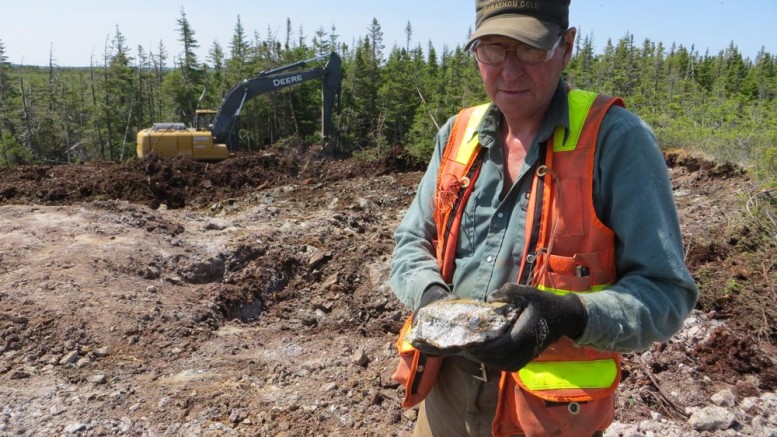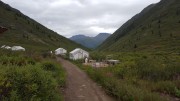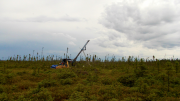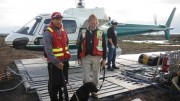Marathon Gold’s (TSX: MOZ) wholly owned Valentine Lake gold project in Newfoundland is one of the few open-pit projects in Canada that isn’t controlled by a major, president and CEO Phillip Walford told The Northern Miner in a recent interview.
All four of its open pits — Leprechaun, Marathon, Victory and Sprite — are in the 2-gram-gold-per-tonne range, are open along strike and at depth, and have underground potential.
“They’re relatively shallow and the deepest hole we have is at 337 metres below surface — that’s not deep for underground,” he says. “It just shows that we have potential, a lot of potential, at depth on these deposits, but we also have potential along strike.”
Walford says only 10% of the 18 km long gold system identified on the property has been looked at in detail, so there is “a lot of blue sky.”
He adds that “there are still large parts of that 18 km where we have no drilling or information. It’s a remarkable system in that it’s large … from one end of that 18 km mineralized structure where we have outcrops and mineralization to the end of it, the veining or mineralization is almost identical. You can’t tell where it came from, which points out that it is a big system.”
Collectively the four pits have measured and indicated resources of 15 million tonnes grading 2.20 grams gold per tonne for 1.06 million oz. gold and inferred resources of 2.2 million tonnes grading 2.85 grams gold for 199,800 oz. gold.
Walford wants to add at least 100,000 oz. gold to the resource before starting a preliminary economic assessment (PEA) in November. “We want to get that 1.1 million oz. we have in measured and indicated up to 1.4 million or 1.5 million before we start the PEA,” Walford says. “We’re not looking at a big increase … we’ve really got almost enough right now.”
The company just raised $3 million in a private placement in May, adding to the $1.5 million it already had in the bank, and plans to drill 7,500 to 8,000 metres this summer to expand the strike length and resources at the Sprite and Victory deposits. (Marathon also gets $100,000 a year in exploration grants from the government of Newfoundland and Labrador.)
Walford reckons that Marathon could complete a PEA in the second quarter of 2017.
In the meantime, the junior is moving ahead with metallurgical testing. (The Research and Development Council of Newfoundland and Labrador paid for 75% of the tests.) So far the results appear promising.
Recoveries via conventional milling at the Leprechaun deposit and the Marathon deposit yielded recovery rates of between 93% and 96%. The Marathon deposit is being tested this year. Those two deposits make up 92% of the resources in the company’s Valentine Lake camp.
Bottle-roll tests to determine recovery rates via heap leaching have come back at 73.6% after 96 hours and were still recovering at the end of the test. Short-column testing is underway at both the Leprechaun and Marathon deposits to assess gold leachability at coarser crush sizes.
The advantages of heap leaching over milling would be lower operating costs (44% less than milling) and lower capital costs (50% less than milling). But there are trade-offs.
“Heap leach would be cheaper but the recovery of gold would probably not be as great, so you have a trade-off between cost and recovery,” Walford says. “We have options … and I should point out that all the heap leaching is being done on fresh rock — there is no oxidized material here at all.”
Walford adds that considering heap leach as part of the operation is a game changer. “One of the questions we’ll have to answer in [the fall] is what kind of operation we’re going to have. Will it be a heap leach for low-grade material and high grade handled by a small mill? It’s a great problem to have.”
The company has also entered the sixth year of environmental studies and so far has found no environmental issues or red flags across its 240 sq. km property. Walford acknowledges that Marathon won’t need to have completed an environmental impact assessment (EIS) for the PEA, but it will be needed for a feasibility study.
“Some of the environmental work we’ve done already will go directly into the EIS — six years of baseline studies, as well as some advanced ecological studies on flora and fauna. I can’t really answer how much more we will need, but the important thing is that all these things require a lot of time, like collecting the data, so we have to do the studies, but the baseline work is done, so that’s a big one, because you can’t collect three years of information in a year.”
Walford notes that Marathon is starting to get noticed, which has lifted the company’s share price. At press time, shares of Marathon Gold traded at 46¢ apiece.
“Part of it is the market, and I would be untruthful to say otherwise,” Walford says. “But it’s also that people are starting to see what we have and there is not a lot out there in Canada that is not already controlled by a major that has more than a million ounces, and has the kind of potential that we have — there just aren’t many of them.”






Be the first to comment on "Marathon Gold sets the stage for PEA"